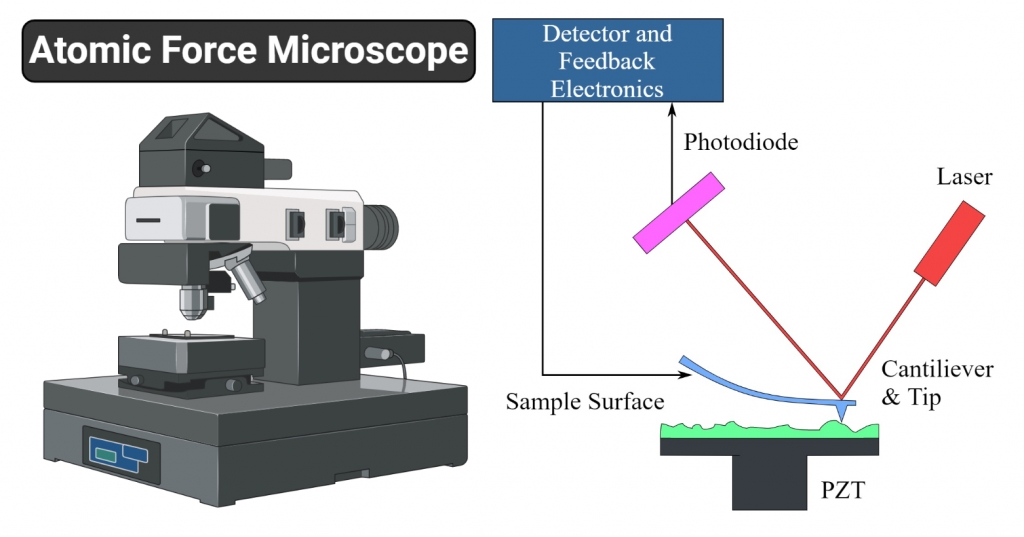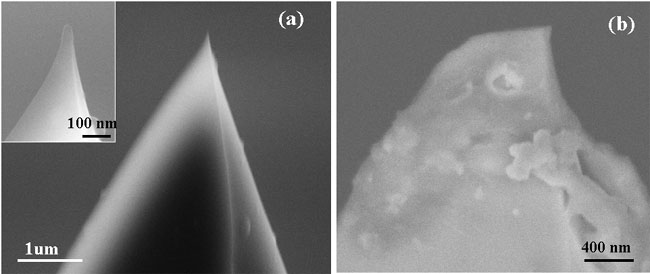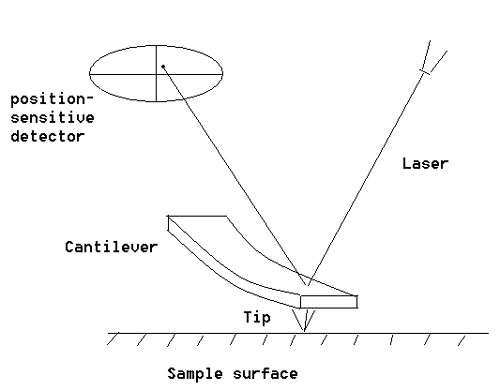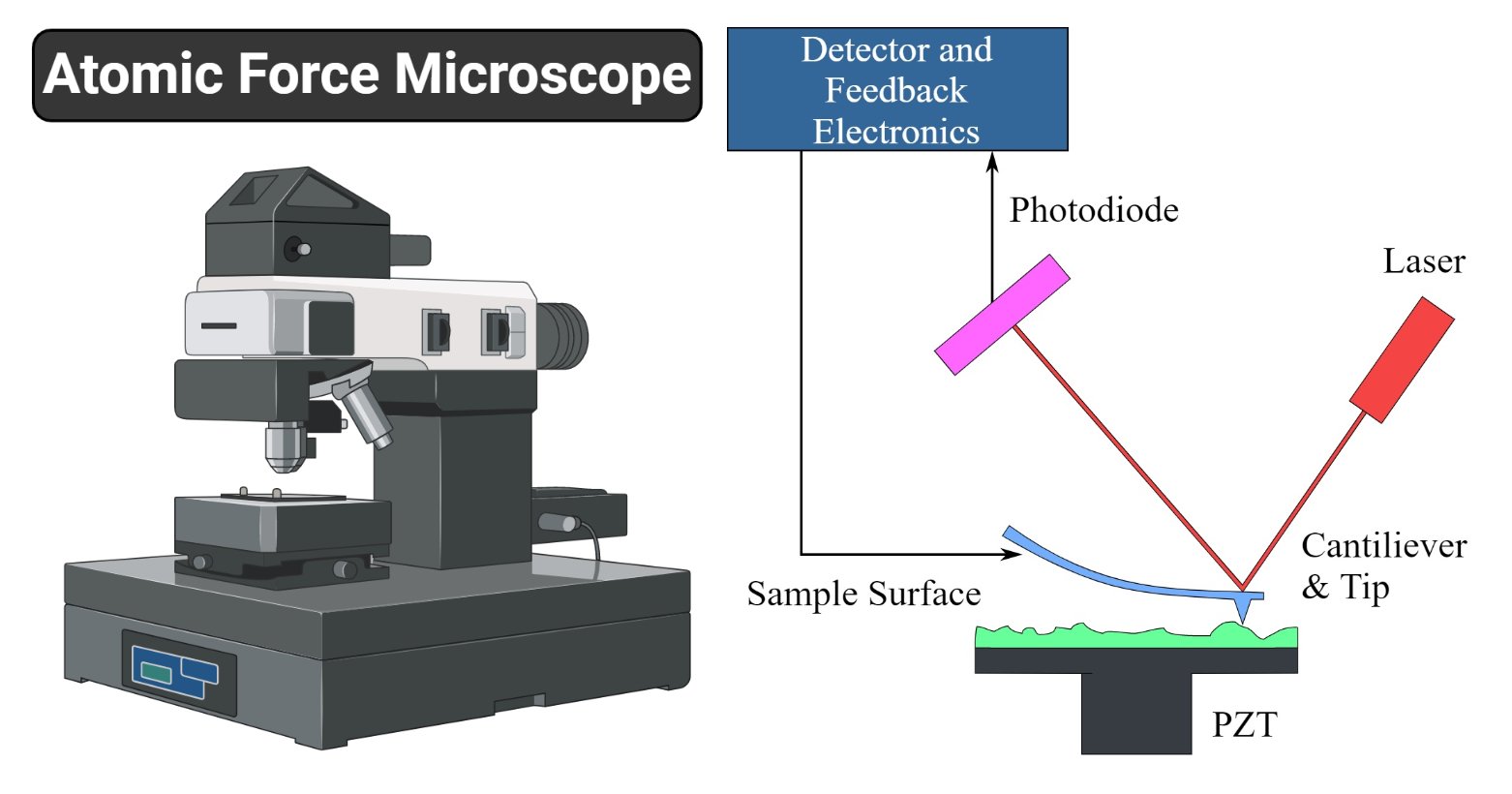مجهر القوة الذريه Atomic Force Microscopy

*
The atomic force microscope (AFM) is one kind of scanning probe microscopes (SPM). SPMs are designed to measure local properties, such as height, friction, magnetism, with a probe. To acquire an
image, the SPM raster-scans the probe over a small area of the sample, measuring the local property simultaneously.
*
?How does AFM work
AFMs operate by measuring force between a probe and the sample. Normally, the probe is a sharp tip, which is a 3-6 um tall pyramid with 15-40nm end radius (Figure 1). Though the lateral resolution of AFM is low (~30nm) due to the convolution, the vertical resolution can be up to 0.1nm.

*1.*(a) A new AFM tip; inset: The end of the new tip. (b) A used AFM tip.
To acquire the image resolution, AFMs can generally measure the vertical and lateral deflections of the cantilever by using the optical lever. The optical lever operates by reflecting a laser beam off the cantilever. The reflected laser beam strikes a position-sensitive photo-detector consisting of four-segment photo-detector. The differences between the segments of photo-detector of signals indicate the position of the laser spot on the detector and thus the angular deflections of the cantilever (Figure 2).

Figure 2.*AFM is working with an optical lever.

Parts of the Atomic Force Microscope
Atomic Force Microscopes have several techniques for measuring force interactions such as van der Waals, thermal, electrical and magnetic force interactions for these interactions done by the AFM, it has the following parts that assist in controlling its functions.
Modified tips which are used to detect the sample surface and undergo deflections
Software adjustments used to image the samples.
Feedback loop control – they control the force interactions and the tip positions using a laser deflector. the laser reflects from the back of the cantilever and the tip and while the tip interacts with the surface of the sample, the laser’s position on the photodetector is used in the feedback loop for tracking the surface of the sample and measurement.
Deflection – The Atomic Force Microscope is constructed with a laser beam deflection system. The laser is reflected from the back of the AFM lever to the sensitive detector. They are made from silicon compounds with a tip radius of about 10nm.
Force measurement – the AFM works and depends highly on the force interactions, they contribute to the image produced. The forces are measured by calculation of the deflection lever when the stiffness of the cantilever is known. This calculation is defined by Hooke’s law, defined as follows:
F= -kz, where F is the force, k is the stiffness of the lever and z is the distance the lever is bent.
Applications of the Atomic Force Microscope
This type of microscopy has been used in various disciplines in natural science such as solid-state physics, semiconductor studies, molecular engineering, polymer chemistry, surface chemistry, molecular biology, cell biology, medicine, and physics.
Some of these applications include
Identifying atoms from samples
Evaluating force interactions between atoms
Studying the physical changing properties of atoms
Studying the structural and mechanical properties of protein complexes and assembly, such as microtubules.
used to differentiate cancer cells and normal cells.
Evaluating and differentiating neighboring cells and their shape and cell wall rigidity.
Advantages of the Atomic Force Microscope
Easy to prepare samples for observation
It can be used in vacuums, air, and liquids.
Measurement of sample sizes is accurate
It has a 3D imaging
It can be used to study living and nonliving elements
It can be used to quantify the roughness of surfaces
It is used in dynamic environments.
Disadvantages of the Atomic Force Microscope
It can only scan a single nanosized image at a time of about 150x150nm.
They have a low scanning time which might cause thermal drift on the sample.
The tip and the sample can be damaged during detection.
It has a limited magnification and vertical range
http://www.nanoscience.gatech.edu/zlwang/research/afm.html
https://microbenotes.com/atomic-force-microscope-afm/
لتصنيع النانو الموجة للتطبيقات الطبية الحيوية الجزء الثاني









من فضلك قم بكتابة تعليق لتظهر لك روابط التحميل